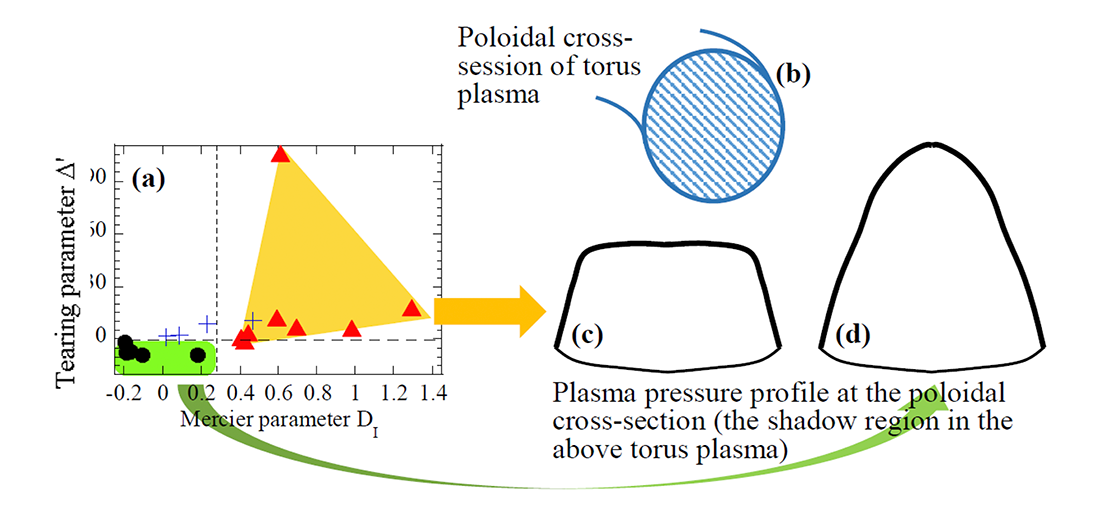Identification of the criteria for the plasma collapse discharge in helical plasmas
In the LHD, the plasma discharges, with the cases predicted to be unstable in MHD instabilities before the construction, are maintained without any collapse phenomena. On the contrary, in the discharges predicted to be much unstable by a theory, the collapse phenomena are observed. We investigate the criteria of the collapse discharges using the measured plasma pressure and current profiles, and identify the criteria leading to the collapse that Mercier parameter >0.3 and tearing parameter >0.

In the LHD, the plasma discharges, with the cases predicted to be unstable in MHD instabilities before construction, are maintained without any collapse phenomena. On the contrary, in the discharges predicted to be very unstable in theory, the collapse phenomena are observed. We investigate the criteria of the collapse discharges, using measured plasma pressure and current profiles, and identify the criteria leading to the collapse that Mercier parameter >0.3 and tearing parameter >0.
According to a previous LHD experiment, based on the linear MHD stability analysis with the observed plasma pressure profile, we already found that, in the LHD plasmas, plasma pressure gradients and the discharges were maintained in the quasi-steady state (see Fig. (d)) even in the predicted cases of MHD instabilities before the construction. The above fact leads to the achievement of the discharge without collapse in the experimental conditions which was expected to be impossible in the LHD design phase.
On the contrary, according to the LHD experiment with the highly unstable MHD conditions such as the high magnetic hill and the low magnetic shear configuration, we observed the collapse phenomena. Then the theoretical prediction based on the linear MHD stability is thought still valid qualitatively, but we have not identified the quantitative criteria that cause the collapse phenomena to happen. The reason is because the identification of the plasma current profile is difficult in the experiment. It should be noted that, in the collapse discharges, the property of the MHD stability strongly depends on the plasma current profile as well as the pressure profile.
In this study, we identify the plasma current profile through the change of the magnetic field, due to the plasma current based on the spectroscopy measurement taking Motional Stark Effect (MSE) into account, and also identify the criteria that make the collapse phenomena happen, using the linear MHD stability analyses, the experimentally identified plasma pressure profile and the plasma current profile. The criteria from using the stability index of the ideal interchange instability and the tearing instability (Mercier parameter DI, and tearing parameter Δ') is shown in Fig. (a). In Fig. (a), the closed circles correspond to the data for the plasmas without magnetic fluctuation, the closed triangles to the first phase of the precursor leading to the collapse, and the plus symbols to the last phase of the precursor.
Here, it should be noted that, according to the previous work, in the green region, plasma pressure is maintained in a quasi-steady state. Then, the green region and the orange region correspond respectively to the conditions without (Fig. (d)) and with (Fig. (c)) the collapse in the discharges. And, according to further linear MHD stability analyses of the internal mode structure and the growth rate dependence on the magnetic Reynolds number, the precursor leading to the collapse appears in the situation with the most purely ideal interchange instabilities.
Moreover, we investigate the time evolution of the plasma pressure gradient and the magnetic shear at the rational surface in the collapse discharges. The reason why the collapse criteria, DI>0.3, is achieved in the first phase of the precursor leading to the collapse, is due to the increase of the pressure gradient at the resonant surface, not the change of the magnetic shear. In the collapse discharges we analyze in this study, the plasma current flows. Then, the reason that the pressure gradient becomes much larger is because the resonant surface moves to the inner radial region where the plasma pressure gradient is larger than that in peripheral region. Then the plasma current does not directly affect the stability properties, but it strongly affects it through the change of the rational surface location.
In fusion plasmas, it is important to make clear the criteria of the pressure gradient collapse, because the fusion power is proportional to the square of the plasma pressure. Therfore the results of this study lead to an important insight in the development of the fusion reactor.
This research result was published on March 5, 2021 in Nuclear Fusion, a journal on controlled thermonuclear fusion by the International Atomic Energy Agency.
